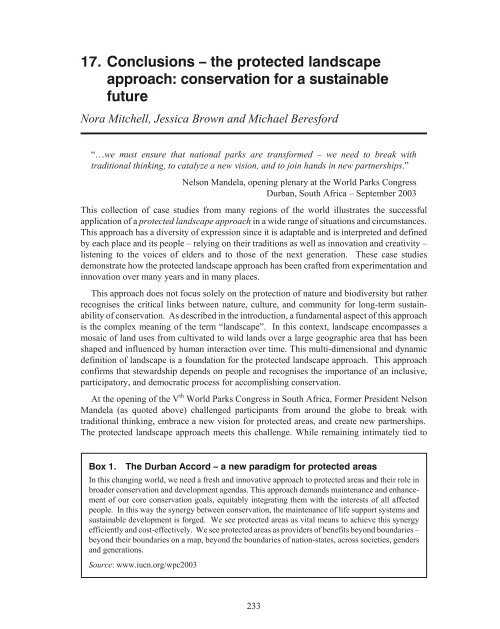The Protected Landscape Approach - Centre for Mediterranean ...
The Protected Landscape Approach - Centre for Mediterranean ...
The Protected Landscape Approach - Centre for Mediterranean ...
You also want an ePaper? Increase the reach of your titles
YUMPU automatically turns print PDFs into web optimized ePapers that Google loves.
17. Conclusions – the protected landscape<br />
approach: conservation <strong>for</strong> a sustainable<br />
future<br />
Nora Mitchell, Jessica Brown and Michael Beres<strong>for</strong>d<br />
“…we must ensure that national parks are trans<strong>for</strong>med – we need to break with<br />
traditional thinking, to catalyze a new vision, and to join hands in new partnerships.”<br />
Nelson Mandela, opening plenary at the World Parks Congress<br />
Durban, South Africa – September 2003<br />
This collection of case studies from many regions of the world illustrates the successful<br />
application of a protected landscape approach in a wide range of situations and circumstances.<br />
This approach has a diversity of expression since it is adaptable and is interpreted and defined<br />
by each place and its people – relying on their traditions as well as innovation and creativity –<br />
listening to the voices of elders and to those of the next generation. <strong>The</strong>se case studies<br />
demonstrate how the protected landscape approach has been crafted from experimentation and<br />
innovation over many years and in many places.<br />
This approach does not focus solely on the protection of nature and biodiversity but rather<br />
recognises the critical links between nature, culture, and community <strong>for</strong> long-term sustain -<br />
ability of conservation. As described in the introduction, a fundamental aspect of this approach<br />
is the complex meaning of the term “landscape”. In this context, landscape encompasses a<br />
mosaic of land uses from cultivated to wild lands over a large geographic area that has been<br />
shaped and influenced by human interaction over time. This multi-dimensional and dynamic<br />
definition of landscape is a foundation <strong>for</strong> the protected landscape approach. This approach<br />
confirms that stewardship depends on people and recognises the importance of an inclusive,<br />
participatory, and democratic process <strong>for</strong> accomplishing conservation.<br />
At the opening of the V th World Parks Congress in South Africa, Former President Nelson<br />
Mandela (as quoted above) challenged participants from around the globe to break with<br />
traditional thinking, embrace a new vision <strong>for</strong> protected areas, and create new partnerships.<br />
<strong>The</strong> protected landscape approach meets this challenge. While remaining intimately tied to<br />
Box 1.<br />
<strong>The</strong> Durban Accord – a new paradigm <strong>for</strong> protected areas<br />
In this changing world, we need a fresh and innovative approach to protected areas and their role in<br />
broader conservation and development agendas. This approach demands maintenance and enhance -<br />
ment of our core conservation goals, equitably integrating them with the interests of all affected<br />
people. In this way the synergy between conservation, the maintenance of life support systems and<br />
sustainable development is <strong>for</strong>ged. We see protected areas as vital means to achieve this synergy<br />
efficiently and cost-effectively. We see protected areas as providers of benefits beyond boundaries –<br />
beyond their boundaries on a map, beyond the boundaries of nation-states, across societies, genders<br />
and generations.<br />
Source: www.iucn.org/wpc2003<br />
233

















